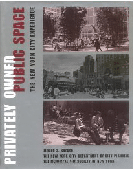
645 Fifth Avenue
Olympic Tower
Over its quarter-century life, the Olympic Tower through-block covered pedestrian space linking East 51st and 52nd Streets has faced the awesome challenge of competing for public space users with one of the world’s greatest shopping streets, Fifth Avenue. Why should anyone go to this space, when Fifth Avenue runs parallel some 50 feet to the west and the space’s existence is not even evident to the average Fifth Avenue pedestrian? If the space were to succeed as a destination, it would have to offer more than simple protection from the elements. Although it contributed to the creation of a parallel pedestrian circulation system, along with the HarperCollins through block arcade to the north, connecting East 51st to 53rd Streets, the closeness of Fifth Avenue would decrease the shortcut appeal. The space’s long-standing history of scant public use, restaurant closings, and absent retail tenants only underscores the difficulty of the competition. At a recent site visit, the space was under renovation, suggesting that its owner is still trying to discover the right design, including amenities, and other uses that would make it a success.

Entered from East 51st Street across from St. Patrick’s Cathedral or from East 52nd Street across from the southern end of the HarperCollins through block arcade, the space observes the two-zone design convention of several enclosed through-block covered pedestrian spaces, dedicating part of the space to circulation and part to destination functions. Here, the western portion is dedicated to movement and access to the elevators for the commercial space in Olympic Tower. Without retail stores or seating along this western side, there is no reason to linger, stop, or change direction.
The eastern portion lying out of circulation’s way accommodates the functional amenities, although the proposed renovation may change this arrangement. Closest to East 51st Street is a small area that has yet to find its identity. Previously used for restaurant seating, general seating, and an adjacent newstand, it has been subject to renovation efforts several times before. Toward the middle are the restrooms and, in the past, a café. Tables and chairs arrayed on two tiers descending northward overlook a granite-backed waterfall and basement-level pool. When the waterfall is in operation, a mirror creates the illusion of more water. A vacant, glass-enclosed room at pool level, visible but inaccessible from above, is all that remains of unsuccessful restaurant efforts. Close to East 52nd Street was the only tiny retail location that had operated consistently, although it appears to be closed.
The presence of a parallel through-block covered pedestrian space so close to Fifth Avenue raises an interesting urban planning question. What is wrong with walking and shopping on Fifth Avenue? That the City at one time allowed, even encouraged, the creation of an alternative circulation network and off-the-street spaces that would draw pedestrians and shoppers away from retailers on Fifth Avenue may seem strange today. In the early 1970s, however, city planners were worried that the Fifth Avenue public sidewalks were becoming so crowded that the experience of shopping and promenading was being compromised. They were also concerned that passive uses such as travel agencies and bank branches were squeezing out active retail uses that made Fifth Avenue the success it was.
To address these issues, the City adopted in 1971 the Special Fifth Avenue District, a zoning district designed, among other things, to “preserve, protect, and enhance the character of Fifth Avenue as the showcase of New York and national retail shopping,” and to “encourage the concentration of major stores, retail clustering, restaurants and related activities which complement the special image and character of this unique area.” Mid-block parallel pathways and interior spaces, strategically deployed, were seen as devices that could alleviate some of the sidewalk congestion, for the greater good of the street. The only problem, of course, was the enormous odds against creating anything remotely providing the vitality of a real street that would in fact siphon off pedestrians. The stretch of Fifth Avenue between East 42nd and 57th Streets offers, in addition to spaces at Olympic Tower and HarperCollins, covered pedestrian spaces at 575 Fifth Avenue, 650 Fifth Avenue, and Trump Tower, an approved permanent passageway at 712 Fifth Avenue, an indoor public access passageway at Tower 49, and through block access at Saks Tower, that accept the challenge.

 (11 votes, average: 4.00 out of 5)
(11 votes, average: 4.00 out of 5)
Photo from 01/12/2024